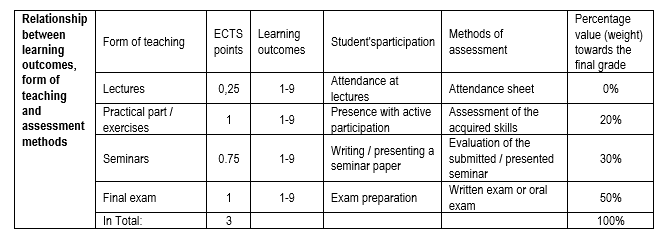Acquiring fundamental knowledge and skills in reanimatology, a field of anaesthesiology and intensive treatment as an integral part of the overall health protection. Permanent monitoring of vital functions of healthy and critically ill patients, ways to recognise changes in vital functions and specific care of patients in life-threatening conditions and in intensive care. Managing complications that arise during general and local anaesthesia, using the newest methods in science, instruments and techniques for pain treatment. Knowing the basic programmes as well as specific techniques of injecting, dose regimen, the right care and using equipment. Covering key topics on general, local anaesthesia, sedation and general anaesthesia, including specific dangers and mistakes in technique which can lead to complications, reanimation and treatment of intensive medicine.
History of anaesthesiology
Preoperative diet
Pre-anaesthetic assessment and preparation of patient for anaesthesia and surgery
ASA-classification of patient
Hemodynamic monitoring in anaesthesiology
Anaesthetic induction: Intravenous and inhaling anaesthetics. Muscle relaxant. Opiate
Complications with general and local anaesthesia
Post- anaesthetic care
Regional anaesthesia. Neuraxial anaesthesia
Peripheral nerve block
Cardiac arrest - cardiopulmonary reanimation – role of individual team members
Procedures of basic life support (BLS) and automated external defibrillator (AED)
Basic and advanced manoeuvres of airway management
Recognising rhythm of cardiac arrest
Defibrillation
Procedures of immediate life support (ILS)
Management of polytrauma patients
Management of neurotraumapatients(rapid neurological exam, AVPU scale)
Acute respiratory insufficiency
Using oxygen on critically ill patients
Intensive care of patient
Mechanical ventilation
Cardiac decompensation, Cardiogenic shock, AMI
Heart failure and circulatory collapse. Cardiogenic shock. Heart attack, conduction disorders
Shock, sepsis and multi organ dysfunction syndrome
Acute pain
Chronic pain
System of pain assessment as vital sign with specific patient groups
Acupuncture and other methods in pain treatment
EWS score system (early warning of patient in life-threatening hospital conditions)
Transport of life-endangered patient
Peripheral (intravenous) line placement in case of emergency,
Participation in central (venous) line placement
Obavezna literatura:
- Sakic Zdravčević K, i sur. Anesteziologija, reanimatologija i intenzivno liječenje (skripta-nastavni tekst) Osijek: Fakultet za dentalnu medicinu i zdravstvo Osijek Sveučilišta J. J. Strossmayera u Osijeku; 2018.
- Sakic Zdravčević K, i sur. Klinička anesteziologija, reanimatologija i intenzivno liječenje (sveučilišni udžbenik). Osijek: Medicinski fakultet Sveučilišta J. J. Strossmayera u Osijeku, Katedra za anesteziologiju, reanimaciju i intenzivno liječenje; 2008.
- Sunyadi-Antičević S, Protić A, Patrk J, Filipović-Grčić B, Puljević D, i sur. Smjernice za reanimaciju Europskog vijeća za reanimatologiju 2015. godine [European resuscitation council guidelines for resuscitation 2015]. Liječnički vjesnik. 2016;138(11-12):305-321.
- Kvolik S, Lovrić I. Suvremeni pristup ranom liječenju politraumatiziranog bolesnika. (priručnik) Osijek: Medicinski fakultet Osijek; 2012.
- Zapisi s predavanja
Dopunska literatura:
Dopunska literatura (u trenutku prijave prijedloga studijskog programa)
1. Šakić i sur.: Regionalna anestezija i analgezija, Medicinska naklada, Zagreb, 2012.
2. Šakić i sur.: Autotransfuzija, tromboprofilaksa i perioperacijsko krvarenje, Medicinska naklada, Zagreb, 2012.
Upon completion of this course, students will be able to:
1. prepare patients for pre-anesthesia examination, general and regional anesthesia for surgery and operative checklist;
2. identify and take appropriate action in a life-threatening patient, including a patient in a life-threatening condition;
3. apply health care to critically ill and respiratory endangered patients in the intensive care unit;
4. apply procedures of monitoring, recognition of vital signs, acute and chronic pain;
5. perform pain assessment and procedures in the treatment of acute and chronic pain;
6. recognize the specifics of caring for a critically ill patient with diagnostic therapeutic procedures in the intensive care unit;
7. prepare the patient for anesthesia procedures under supervision;
8. assess the effects of anesthesia, participation in post-anesthesia care and procedures in case of adverse events;
9. know and prepare the anesthesia machine and respirator



